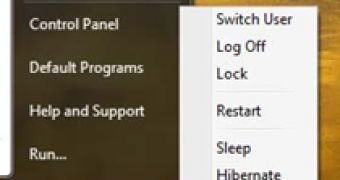I am going to assume that you are unfamiliar, or little familiar with the Shut Down options in Windows Vista and explain the differences between them. Because, in Vista, one of the UI aspects that was upgraded delivers a total of 7 alternatives to exiting Vista. Some of them are intuitive by nature. But there are nuances. As Nathan Weinberg over at InsideMicrosoft observes, Windows is about a variety of user options: "redundancies and choice are the second most important reason to use Windows (the first being backwards compatibility), and without it, Windows would just be a Mac."
The start Menu in Windows Vista enables access to a total of seven options. Here, they are from top to bottom: Switch User, Log Off, Lock, Restart, Sleep, Hibernate and Shut Down. Right. Just to help so you don't get lost, Microsoft is delivering easy access to the Shut Down and Lock options via two buttons integrated in the design of the Start Menu. The adjacent options are available via a closed menu that can be activated via a third button.
Well? I'm sure that you are already familiar with Shut Down and Restart, so I am going to skip them entirely. Switch User lets another user log in while the first account remains active. Log Off completely deactivates the account. Lock is perhaps redundant. As it presents a lock screen that enables switching the user.
Sleep and Hibernate are equal, but not the same. Sleep moves the machine in a temporary low-power state. If the computer remains inactive for a given period of time, Sleep automatically turns to Hibernate. Hibernate mode addresses mostly laptop users, because Sleep keeps the computer active and it consumes resources.

 14 DAY TRIAL //
14 DAY TRIAL //